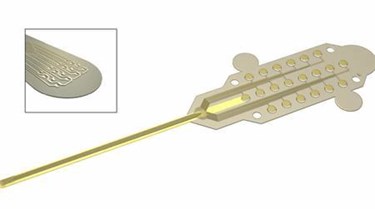Graphene-Based Neural Probes Monitor Brain Activity In High Resolution

A consortium of European scientists has developed a probe to monitor brain activity in high resolution using graphene, a material that offers additional flexibility while maintaining biocompatibility. The probe is the latest advance from Europe’s $1.08-billion investment in the development of graphene technology, Graphene Flagship.
Current biomedical research in graphene — an extraordinarily thin yet stable substance capable of conducting both heat and electricity — is exploring applications in multiple fields, including glucose-monitoring wearable patches and tissue engineering. Though many experts don’t expect graphene to yield commercially viable technology until 2020, Korea, China, the U.S., and the U.K. all have made significant investments in pursuit of the next great medical breakthrough enabled by graphene’s unique mechanical properties.
In 2013, the European Union (EU) launched its largest ever research initiative, with $1.08 billion earmarked for emerging technology that incorporates graphene, and the project has partnered with over 150 academic institutions and industrial research groups. The funding is to be spread over 10 years and is intended to make Europe a hub of graphene technology, according to IEEE Spectrum. Partner scientists in Graphene Flagship recently introduced research exploring the potential of graphene-based optical fiber lasers to be used in surgery and spectroscopy.
The project aimed at introducing graphene-based neural probes brought together scientists from academic institutions and research organizations in both Germany and Spain. The addition of graphene into brain monitoring offers high spatial resolution while maintaining an “excellent signal to noise ratio.” The research team, led by Jose Antonio Garrido, a scientist from the Catalan Institute of Nanoscience, published its results in 2D Materials.
“Graphene is one of the few materials that allows recording in a transistor configuration and simultaneously complies with all other requirements for neural probes, such as flexibility, biocompatibility, and chemical stability,” said Benno Blaschke, a researcher from the Technical University of Munich and lead author of the study, in a press release. The challenge of the project, according to Blaschke, was developing a “wafer-scale” fabrication process that could transfer the team’s original design from rigid substrates to the much more flexible graphene.
Researchers used the technology to record pre-epileptic activity in rats, as well as to gauge the rats’ response to light stimulation during sleep. According to Garrido, initial results indicate the strong potential of graphene in neural applications, such as brain stimulation therapies, brain interfaces with prosthetic devices, and clinical monitoring equipment.
“Currently, the focus [of neural implant research] is on ultra-soft materials that can adapt conformally to the brain surface,” said Garrido. “Graphene neural interfaces have already shown great potential, but we have to improve on the yield and homogeneity of the device production in order to advance towards a real technology.”
Related, scientists at the University of Glasgow recently introduced graphene-based “electronic skin” that can be powered by harvesting solar energy. Researchers said the same principles could be applied to other kinds of wearables that monitor vital signs.
